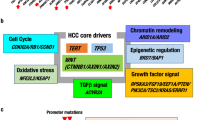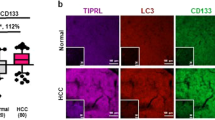Abstract
Liver cancer is very common worldwide and the rates of hepatocellular carcinoma (HCC) have increased by over 70% in the last 2 decades in the US. Late diagnosis, because of the lack of clinical symptoms, and decreased hepatic function, because of underlying hepatic disease, lead to the extremely high mortality rates associated with HCC. Clearly, the identification of markers that are expressed early in the development of HCC and that are easily detected in high-risk patients would aid in early diagnosis and increased survival. We present the cloning and characterization of a novel gene, CRG-L2 (Cancer related gene-Liver 2), which displays high expression in murine and human hepatocellular carcinomas. Using in situ hybridization, we show that CRG-L2 mRNA levels are increased early during the development of liver tumors in C3H/HeJ mice, and that in normal tissues CRG-L2 mRNA is restricted to the murine testis and human placenta. Its restricted expression in normal tissues and unique early upregulation during tumor development make CRG-L2 an excellent candidate as a new clinical marker of HCC.
This is a preview of subscription content, access via your institution
Access options
Subscribe to this journal
Receive 50 print issues and online access
$259.00 per year
only $5.18 per issue
Buy this article
- Purchase on Springer Link
- Instant access to full article PDF
Prices may be subject to local taxes which are calculated during checkout





Similar content being viewed by others
References
American Cancer Society. (2002). Cancer Facts Figures, 1–44.
Borscheri N, Roessner A and Roecken C . (2001). Am. J. Surg. Pathol., 25, 1297–1303.
Bosch FX, Ribes J and Borras J . (1999). Semin. Liver Dis., 19, 271–285.
Brinkman U, Vasmatzis G, Lee B, Yerushalmi N, Essand M and Pastan I . (1998). Proc. Natl. Acac. Sci. USA, 95, 10757–10762.
El-Serag HB and Mason AC . (1999). N. Engl. J. Med., 340, 745–750.
Gilboa E . (1999). Immunity, 11, 263–270.
Graveel CR, Jatkoe T, Madore SJ, Holt AL and Farnham PJ . (2001). Oncogene, 20, 2704–2712.
Hanigan MH, Kemp CJ, Ginsler JJ and Drinkwater NR . (1988). Carcinogenesis, 9, 885–890.
Koen H, Pugh TD, Nychka D and Goldfarb S . (1983). Cancer Res., 43, 702–708.
Kulkarni N, Karavanich CA, Atchley WR and Anholt RRH . (2000). Genet. Res., 76, 41–50.
Lukas ER, Bartley SM, Graveel CR, Diaz ZM, Dyson N, Harlow E, Yamasaki L and Farnham PJ . (1999). Mol. Carcino., 25, 295–303.
Micales BK and Lyons GE . (2001). Methods, 23, 313–323.
Moore MR, Drinkwater NR, Miller EC, Miller JA and Pilot HC . (1981). Cancer Res., 41, 1585–1593.
Ono T, Kurashige T, Harada N, Noguchi Y, Saika T, Niikawa N, Aoc M, Nakamura S, Higashi T, Hiraki A, Wada H, Kumon H, Old L and Nakayama E . (2001). Proc. Natl. Acad. Sci. USA, 98, 3282–3287.
Rainov NG, Dobberstein KU, Fittkau M Bahn H, Holzhausen HJ, Gantchev L and Burkert W . (1995). Clin. Cancer Res., 1, 775–781.
Richards JE, Ritch R, Lichter PR, Rozsa FW, Stringham HM, Caronia RM, Johnson D, Abundo GP, Willcockson J, Downs CA, Thompson DA, Musarella MA, Gupta N, Othman MI, Torrez DM, Herman SB, Wong DJ, Higashi M and Boehnke M . (1998). Opthalmology, 105, 1698–1707.
Rigby PWJ, Dieekmann M, Rhoades C and Berg P . (1977) J. Mol. Biol., 113, 237–251.
Scanlan MJ, Altorki NK, Gure AO, Williamson B, Jungbluth A, Chen YT and Old LJ, (2000). Cancer Lett., 150, 155–164.
Scanlan MJ, Gordon CM, Williamson B, Lee S-Y, Chen Y-T, Stockert E ., Jungbluth A, Ritter G, Jäger D, Jäger E, Knuth A and Old LJ . (2002). Int. J. Cancer, 98, 485–492.
Song B, Chung C, Kim JA, Choi W, Suh DD, Pyo S, Shin JW, Lee HC, Lee YS and Suh DJ . (2002). Cancer, 94, 175–180.
Struss AK, Romeike BF, Munnia A, Steudel WI, Konig J, Ohgaki H, Feiden W, Fischer U and Meese E . (2001). Oncogene, 20, 4170–4174.
Türeci O, Sahin U, Zwick C, Koslowski M, Seitz G and Pfreundschuh M . (1998). Proc. Natl. Acad. Sci. USA, 95, 5211–5216.
Vesselinoviteh SD, Hacker HJ and Bannasch P . (1985). Cancer Res., 45, 2774–2780.
Zhang J, Liu W-L, Tang DC, Chen L, Wang M, Pack SD, Zhuang Z and Rodgers GP (2002). Gene, 283, 83–93.
Acknowledgements
We thank RK Hyde, S Moran, and C Sattler for technical assistance; J Ross for his generous gift of reagents; S Perry for the hydrophobicity analysis, the R Burgess lab, especially N Thompson, for their assistance with protein expression, and the Farnham lab for critical review of the manuscript. This work was supported in part by research grants from the National Cancer Institute/National Institutes of Health CA22484, National Institute of General Medical Sciences/National Institutes of Health GM08349, and National Cancer Institute/National Institutes of Health CA14520.
Author information
Authors and Affiliations
Corresponding author
Rights and permissions
About this article
Cite this article
Graveel, C., Harkins-Perry, S., Acevedo, L. et al. Identification and characterization of CRG-L2, a new marker for liver tumor development. Oncogene 22, 1730–1736 (2003). https://doi.org/10.1038/sj.onc.1206309
Received:
Revised:
Accepted:
Published:
Issue Date:
DOI: https://doi.org/10.1038/sj.onc.1206309
Keywords
This article is cited by
-
Olfactomedin Domain-Containing Proteins: Possible Mechanisms of Action and Functions in Normal Development and Pathology
Molecular Neurobiology (2009)



